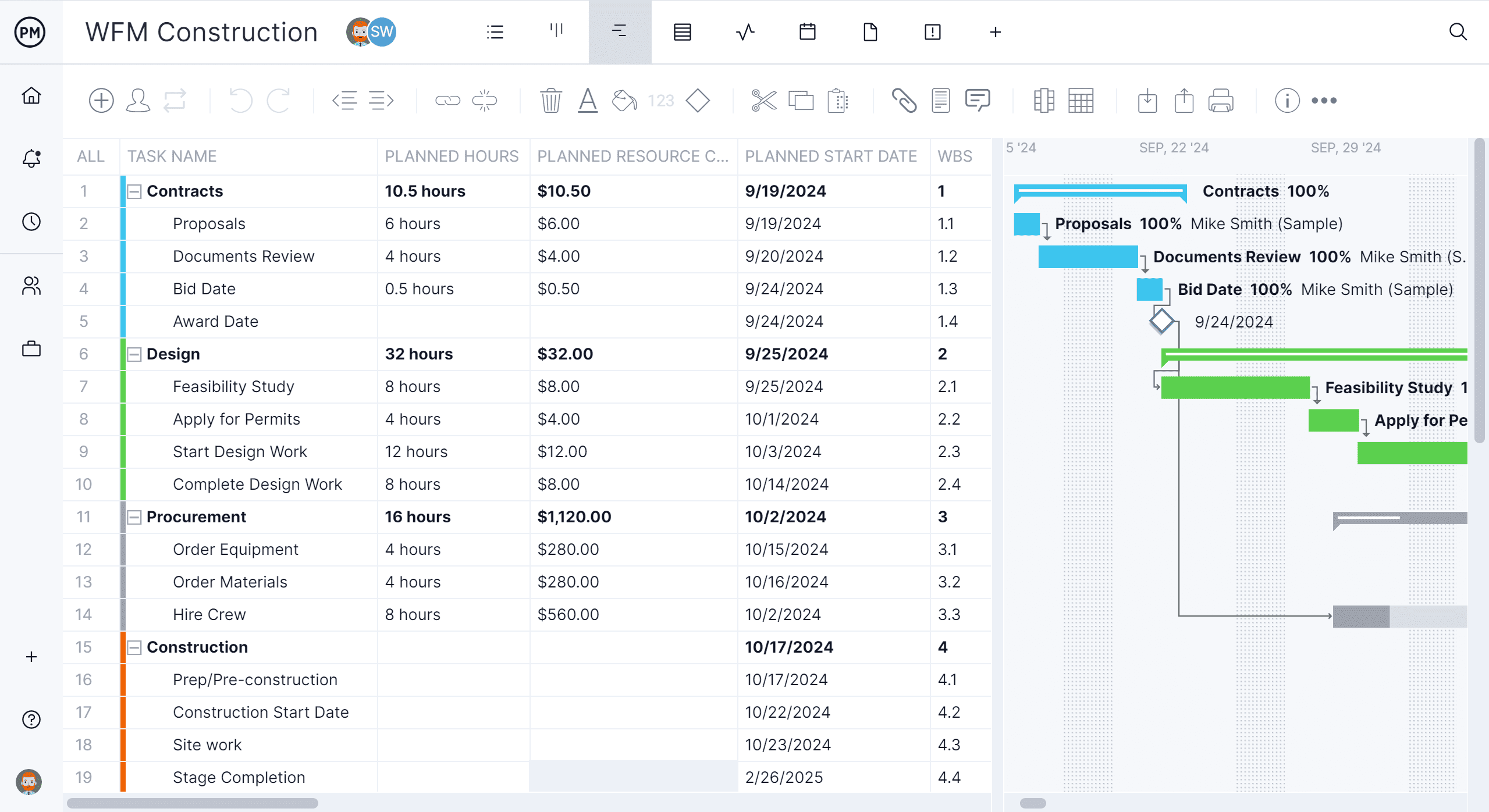- What Is a Project?
- What Is Project Management?
- Project Management Definition from a PMP
- Project Management History
- What Is the Importance of Project Management?
- Key Benefits of Project Management
- Who Uses Project Management?
- What Are the Areas of Project Management?
- What Are the 5 Steps In the Project Management Process?
- Project Management Tips & Best Practices
- What Types of Project Management Exist?
- What Tools Are Used In Project Management?
- Project Management Templates
- What Are the Key Project Management Roles?
- How to Start a Project Management Career
- Which Are the Best Project Management Certifications?
- What Is Project Management Software?
What Is a Project?
A project can be simply defined as an endeavor that involves completing tasks to achieve an objective with a limited set of resources and a finite timeline. Based on this definition, it’s clear that most businesses, nonprofits, governments and other types of organizations execute projects of some sort and therefore, need to implement a project management process.
Now that we’ve established what a project is, let’s go over a simple project management definition.
What Is Project Management?
Project management is a process that allows project managers to plan, execute, track and complete projects with the help of a project team. To do so, they must use project management principles, skills, methodologies and tools to lead team members through each of the project management steps which are known as the project lifecycle.
Project management is made up of five key components: initiation, planning, execution, monitoring and controlling, and project closure. Initiation defines the project objectives and its feasibility. Planning outlines tasks, timelines, resources and budgets. Execution implements that plan, while monitoring and controlling track the project progress against that plan. Finally, project closure delivers the final output and obtains stakeholder approval, among other things.
However, project management can’t be defined just a few paragraphs. In this guide, we’ll cover the basic concepts you need to know to understand what project management is, the stages of the project management process, different types of project management approaches and the tools you can use for managing projects.
In addition, you’ll need project management software to plan, execute and track projects. ProjectManager, for example, has the project planning, scheduling and tracking features you need to manage timelines, resources, costs and teams in one online tool. Use our Gantt charts, kanban boards, and calendars to create project schedules and assign work with real-time resource availability. Get started for free today.
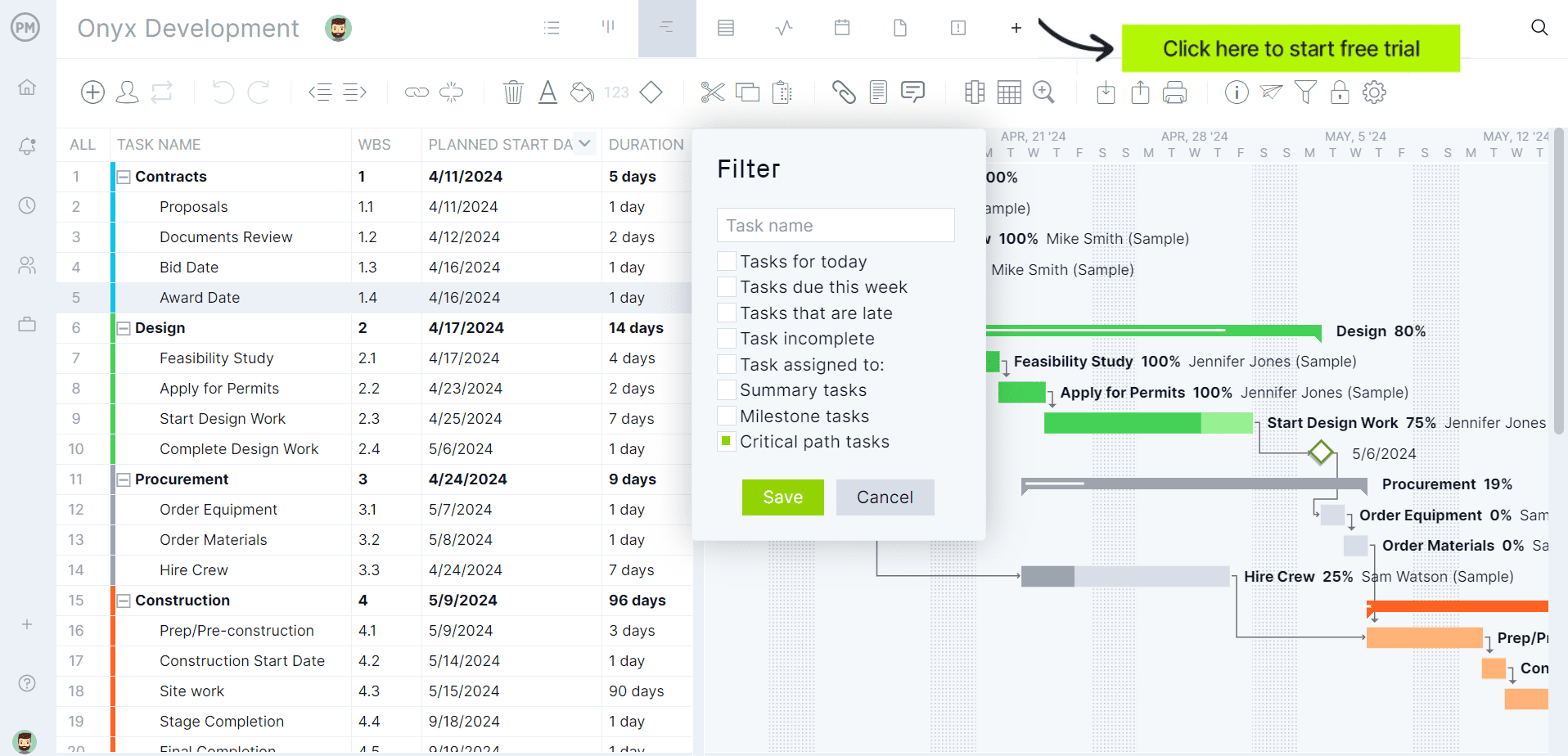
However, the best person to ask for a definition of project management is a project management professional. There are many certifications available, but the gold standard is the project management professional (PMP) certification from the project management institute (PMI).
Project Management Definition from a PMP
Watch Jennifer Bridges, PMP, to understand a fundamental definition of project management. She even dives into some of the key skills, tools and techniques required to practically execute project management.
Project management is closely related to other disciplines including program management and portfolio management. However, while they’re similar, they’re not exactly the same. Here’s how they differ.
What Is the Difference Between Project Management and Program Management?
Program management uses the same principles and techniques as project management, but as its name suggests, it consists of managing programs instead of projects. Programs are a group of related projects that are executed simultaneously to make the most out of an organization’s available resources which presents unique challenges for project management professionals.
What Is the Difference Between Project Management and Project Portfolio Management?
The main difference between project management and project portfolio management is that the latter focuses on managing multiple projects and programs simultaneously to achieve the business objectives and strategic goals of an organization.
Because of its wider scope, project portfolio management involves multiple project managers, program managers and project portfolio managers, which usually work together under the same project management office.
Now, let’s review the history of project management and explain its importance for organizations in any industry.
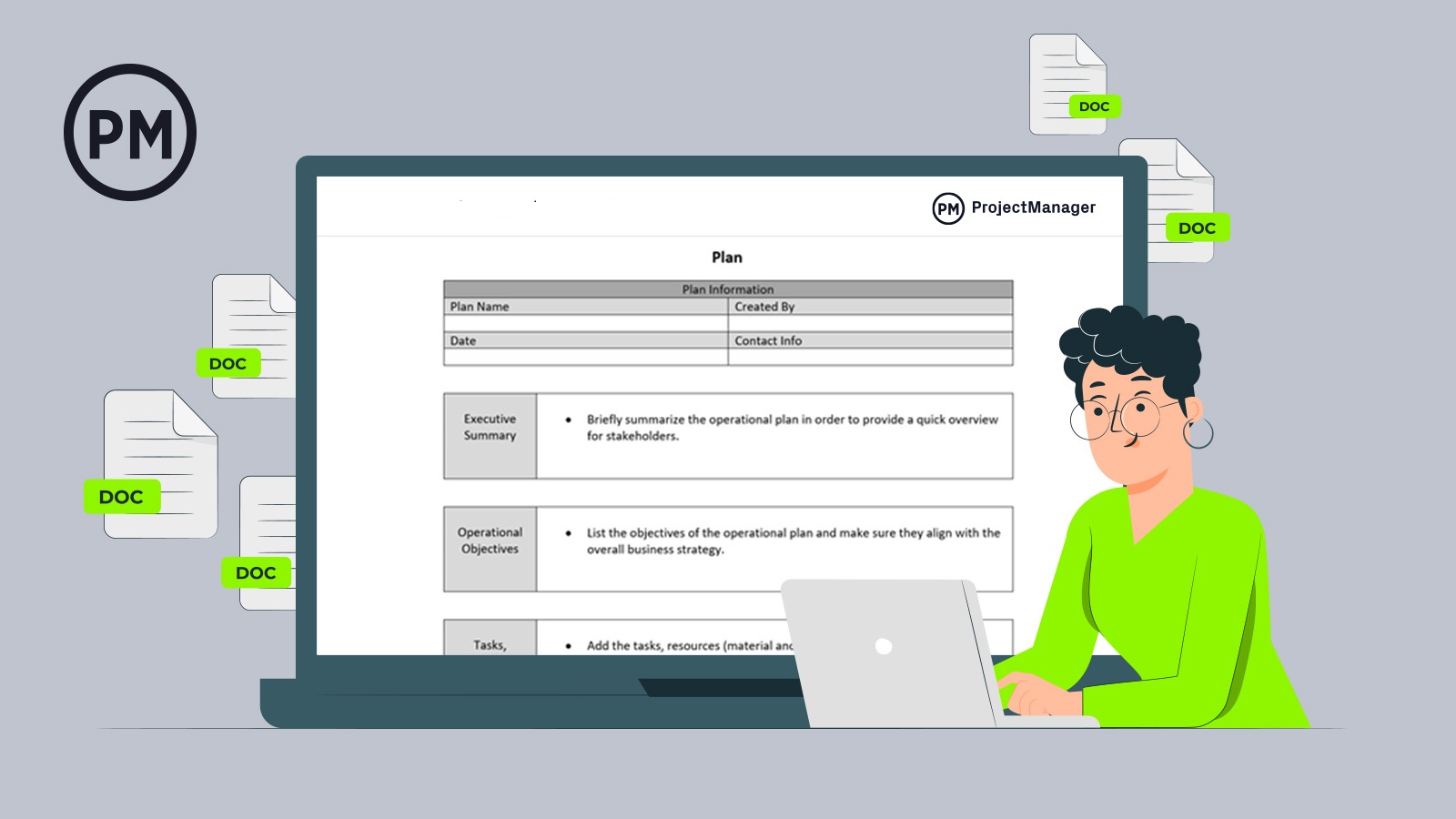
Get your free
Project Plan Template
Use this free Project Plan Template for Word to manage your projects better.
Project Management History
Project management as we know it today began taking shape roughly in the 1950s when foundational tools and techniques of project management such as the critical path method (CPM), work breakdown structure (WBS) and the program evaluation and review technique (PERT) were created.
However, the origins of project management can be traced back to 1896 when Karol Adamiecki created the harmonogram, which was the inspiration for the Gantt chart, which was later created in 1910 by Henry Gantt and remains one of the most important project management tools today. The origins of project management are closely related to construction, engineering, scientific management and even military research.
Now that we’ve defined what project management is and where it came from, let’s review how it can be implemented by organizations by reviewing the project management steps.
Related: 25 Free Project Management Templates for Excel
What Is the Importance of Project Management?
In a nutshell, project management is important because it helps organizations control all the moving parts of projects to bring them to successful completion. These moving parts are known as project management areas, which are key project aspects that must be overseen as projects progress.
Another important aspect of of project management is that it’s flexible. People can manage projects with traditional methodologies, such as waterfall, but new techniques are developed all the time. One such modern approach to project management is agile, which came up through software development, where its iterative style fit better into the way software developers worked.
Not every project is managed one way, though. That’s why you’ll likely benefit from a hybrid approach to project management. This allows cross-functional teams to work within a methodology that suits their needs and still be able to collaborate with other departments that work in different styles.
The benefits of project project management are almost too many to list. But, let’s try it anyway!
Key Benefits of Project Management
Let’s list some of the project management benefits to get a more specific idea of the value of using project management to deliver outputs.
- Improved planning and organization: A structured approach defines objectives, scope, timelines and resource allocation, while efficient use of resources reduces waste and optimizes productivity.
- Enhanced communication: Helps with stakeholder engagement by having regular updates and reports to keep them informed, and defined roles and responsibilities foster better teamwork and accountability.
- Increased efficiency: Project management streamlines processes for better decision making and execution, and it identifies risks early to allow for proactive mitigation, reducing delays and costs.
- Higher quality deliverables: By focusing on goals and continuous monitoring and control, deliverables are more likely to meet quality standards and stakeholder expectations. Regular reviews and adaptations also improve the quality of work.
- Better time management: Accurate estimation of timelines creates more realistic and effective schedules.
- Cost control: Detailed budget and financial tracking keeps project within financial constraints.
Who Uses Project Management?
Anyone who is responsible for managing a project is going to benefit from using project management. That can be in the corporate sector, such as project managers and executives; IT, such as software development teams and IT departments; construction and engineering, such as construction managers, architects and engineers; healthcare professionals; marketing and advertising managers and their teams; the education field; nonprofits; government; research and development; freelancers and consultants; and event planners.
What Are the Areas of Project Management?
Here’s a quick definition of each of the 10 project management knowledge areas, first defined by the Project Management Institute (PMI) in its Project Management Body of Knowledge (PMBOK).
- Scope management: Managing the scope of a project, which refers to the tasks, deliverables and milestones that should be delivered.
- Schedule management: Creating a project schedule and setting guidelines for how it’ll be tracked and maintained.
- Cost management: Estimating project costs to create a budget which is then tracked throughout the project.
- Quality management: Ensuring project deliverables meet quality standards.
- Resource management: Acquiring, allocating and tracking project resources like labor, materials and equipment.
- Communication management: Defining communication guidelines for project teams and stakeholders.
- Risk management: Identifying, evaluating and preventing or mitigating risks in your project.
- Procurement Management: Acquiring project resources and maintaining relationships with vendors and suppliers.
- Stakeholder management: Identifying project stakeholders, and managing them based on their expectations and influence over projects.
- Integration management: Creating a framework that helps project teams work better together.
These project management knowledge areas need to be managed during each step of the project management process.
Related: PMBOK: The Project Management Body of Knowledge Explained
What Are the 5 Steps In the Project Management Process?
The project management process consists of five steps or phases that all projects must go through: initiation, planning, execution, monitoring and control and closure. These project management steps are also known as process groups, the project management cycle or the project lifecycle. Let’s review each of these steps.
1. Project Initiation
This is the starting phase where the project manager must prove that the project has value and is feasible through a series of project management documents. Here are the most important ones:
- Business case: A business case justifies the need for the project, project objectives and return on investment.
- Feasibility study: A feasibility study proves that the project can be executed within a reasonable time and cost.
- Project charter: A project charter conveys what the project is going to deliver.
Once the project gets approved, the project manager must assemble a project team and set up a project management office. The project initiation phase ends with a kickoff meeting, which is when project goals and scope are defined.
2. Project Planning
The goal of the project planning phase is the creation of the project plan, a comprehensive project document that explains in great detail how the project will be executed. Here’s a quick overview of the most important sections of a project plan.
- Project schedule: The project schedule defines a timeline for the execution of tasks and resource allocation.
- Project budget: A project budget is the sum of all the estimated project costs.
- Scope management plan: Explains how your project scope will be tracked throughout the project.
- Risk management plan: Explains the risks that might affect the project, along with strategies to mitigate them.
- Resource management plan: Describes how your resources will be obtained, allocated and managed during the project.
- Stakeholder management plan: Identifies all project stakeholders and the guidelines to manage them.
Project managers often lay out their project plan using Gantt chart software, which provides a visual representation of the entire project schedule and project scope. Some Gantt charts automatically identify critical path activities.
3. Project Execution
The third project management phase is project execution, which is when the project plan is executed to meet the project goals and objectives.
The project execution phase is when project managers need to oversee the project management knowledge areas as their project progresses toward the monitoring and control phase.
Along the way, the project manager make changes to the project execution plan such as reallocating resources or adjusting the time and scope as needed to keep the team working. In addition, they’ll identify and mitigate risks, deal with problems and incorporate any changes.
4. Project Monitoring and Control
The fourth project management phase, project monitoring and control, takes place concurrently with the execution phase of the project. It involves monitoring the progress of the project execution activities to ensure the project team stays on schedule and within budget. Quality control procedures are applied to guarantee quality assurance.
Reporting is also a critical part of this project management phase. First, it allows project managers to track progress, and second, it provides data for stakeholders during presentations to keep them in the loop. There are many project management reports such as project status, timesheets, workload, allocation and expense reports.
5. Project Closure
The fifth project management phase is project closure, in which the final project deliverables are presented to the stakeholders. Once approved, resources are released, documentation is completed and everything is signed off on.
Project Management Processes Explained By a PMP
Watch as Jennifer Bridges, PMP, explains the project management life cycle. She explains the difference between the delivery process and the project management process.
Project Management Tips & Best Practices
Now that we understand project management better, let’s learn some project management tips. These project management best practices are useful for people new to project management and can even help seasoned professionals. Remember, perfecting project management skills is a life-long process.
Write Documents and Reports Throughout the Project Management Process
Documenting work and generating reports are important throughout the entire life cycle of a project. Certainly, they are extra-important during execution to ensure that the actual progress is aligned with the project plan. But reports are communication tools to keep team members updated and stakeholders informed.
Establish Project Controls to Monitor Time, Budget and Scope
Project controls, key performance indicators (KPIs) and project metrics are all measurements that allow project managers to determine if work is being done on time, within budget and meeting quality standards. By establishing these controls, a project manager can make adjustments as needed to keep the project on track.
Use Project Management Software
Project management software was developed to manage projects. It often delivers real-time data, which helps make more informed decisions. Project management software also has features that make project management more efficient, from Gantt charts to schedule work to dashboards and reports to monitor progress, time and costs. Some tools include robust resource, risk and portfolio management, too.
What Types of Project Management Exist?
Through the years, many project management methodologies have been developed to adjust to the needs of different industries. Some of these project management types or approaches also work best for projects of certain sizes and complexity levels.
Here’s a list of the main project management methodologies. Click the links for an in-depth explanation of each.
Waterfall Project Management
Waterfall is a linear project management approach, in which stakeholder requirements are gathered at the beginning of the project, and then a sequential project plan is created. This traditional project management methodology is done in distinct phases, where one must be completed before the next begins.
Agile Project Management
An iterative project management approach that doesn’t follow a rigid project plan, but instead short sprints of work called agile sprints. Agile project management is an incremental approach to managing projects, which grew out of software development but has since been used in various other industries.
Scrum Project Management
An agile framework that’s very popular for product and software development. It is designed to facilitate collaboration, flexibility and iterative progress in project development.
Lean Project Management (or Lean Manufacturing)
This technique was invented to improve manufacturing processes and became a very important project management methodology through the years. Lean focuses on maximizing value while minimizing waste throughout the project life cycle.
Kanban Method
Kanban is a widely used project management approach that consists of managing work through visual boards and cards. Kanban boards are used by agile and scrum teams. Kanban project management optimizes workflows, particularly in lean and agile environments.
Six Sigma
Just like kanban or lean, six sigma is a set of tools and techniques that were developed to improve production processes and later became a project management approach. Six Sigma is a data-driven methodology that is focused on reducing variability and enhancing quality in order to achieve near-perfect performance.
Critical Path Method (CPM)
The critical path method is a project scheduling technique that allows project managers to estimate the duration of a project, identify task dependencies, float and critical activities. CPM determines the longest sequence of dependent tasks that must be completed to ensure a project is finished on time and helps project managers effectively allocate resources, manage schedules and anticipate potential delays.
Critical Chain Project Management
A project management approach that’s based on the theory of constraints and uses resource management as the primary way to execute projects effectively. Critical chain project management focuses on managing the uncertainties, task dependencies and resource restrictions that can affect project schedules.
PRINCE2
PRINCE2 is the most popular project management methodology in the UK, Australia, and European countries. PRINCE2 is very similar to the Project Management Body of Knowledge from the PMI because it provides definitions and best practices for project managers. It’s a structured project management methodology that provides a systematic approach to managing projects, emphasizing organization, control and effective communication throughout the project life cycle.
What Tools Are Used In Project Management?
There is a wide range of project management tools, both online and mobile, available to manage projects. These are the most essential tools for a project manager:
Project Dashboard
A project dashboard is a project-tracking tool that allows you to monitor your costs, tasks and progress. It’s a very useful tool during project execution because it helps project managers quickly determine whether their projects are on track.
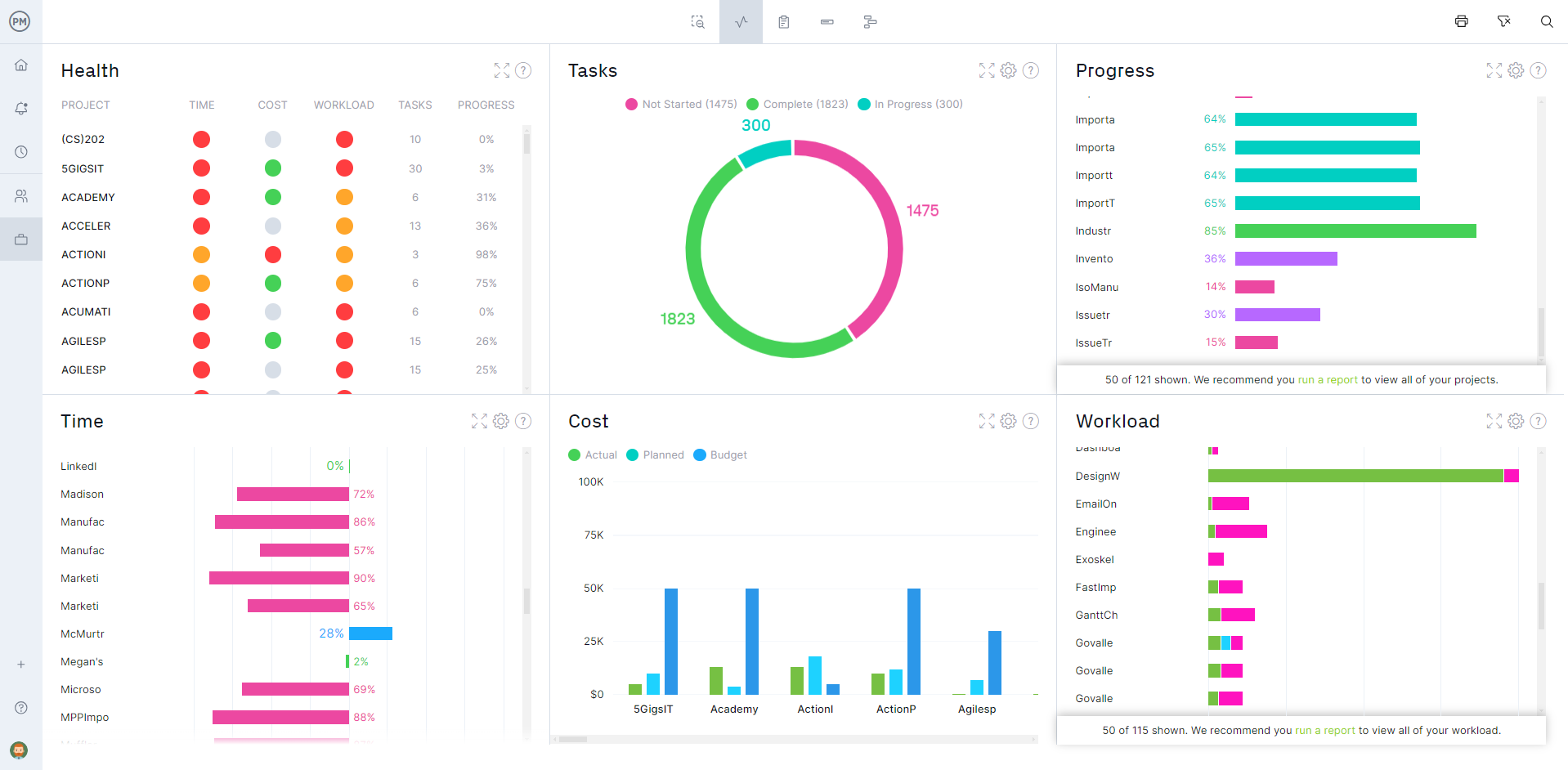
Gantt Charts
A Gantt chart is a visual representation of a project timeline that shows all the project tasks in one graph. Gantt charts are used for project planning, project scheduling, task management and resource management. They work best on waterfall projects.
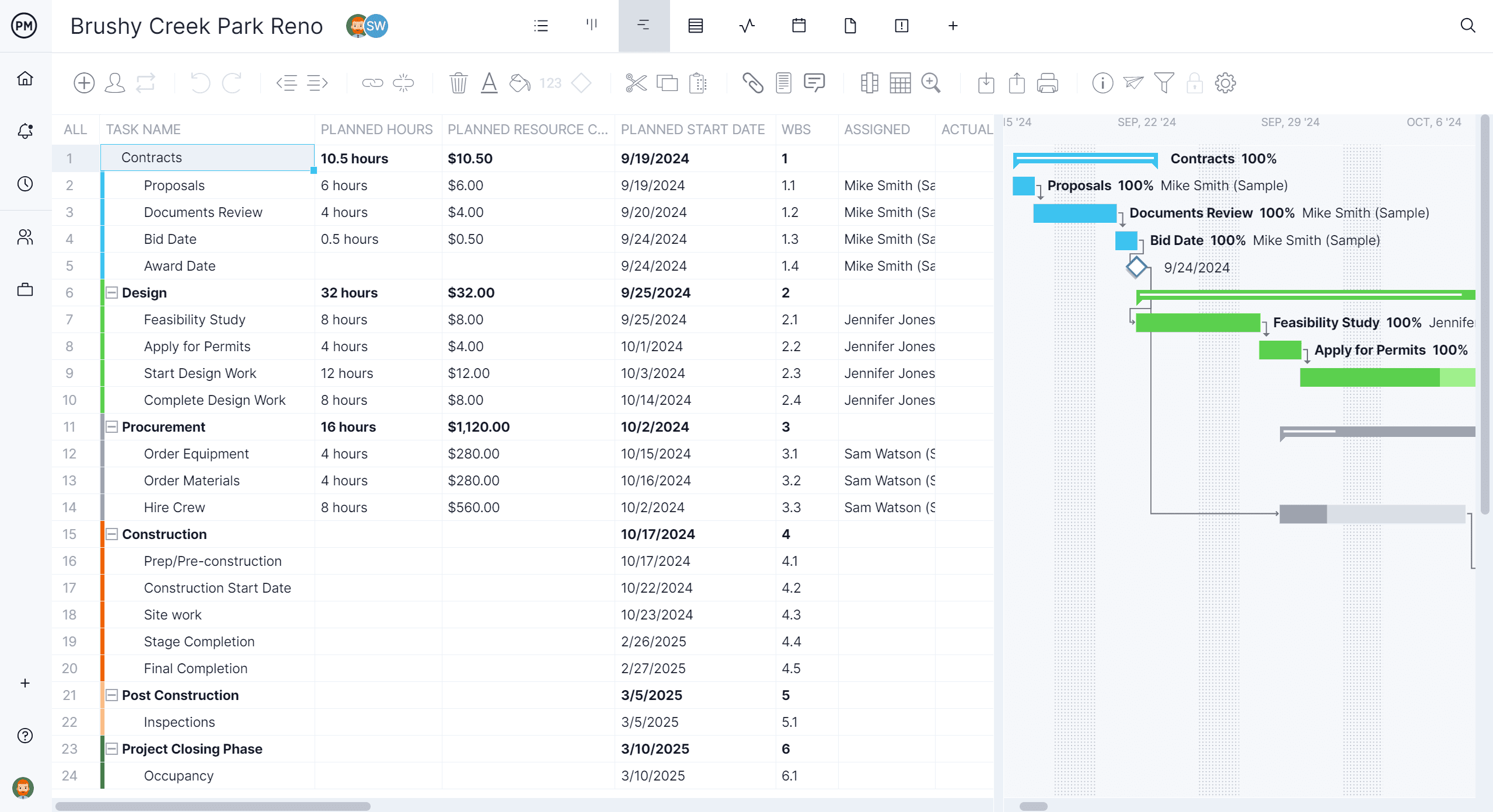
The Gantt chart is the preferred method used by project managers to schedule their projects. Some tasks are dependent on others before they can start or end, and these task dependencies can create bottlenecks later in the project.
By linking them on a Gantt chart, task dependencies help avoid slowing down the schedule. Projects can be divided by milestones and diamond symbols, which indicate the end of one phase and the beginning of the next.
Kanban Boards
A kanban board is a task management tool that allows project managers and team members to visualize tasks. Kanban boards are used by agile and scrum teams who work in iterative sprints. They’re easy to use and foster team collaboration.

Project Management Templates
There are many project management charts and diagrams that project managers use to plan, schedule and track their projects. Here are some of the most commonly used ones.
- Gantt Chart Template
- Project Plan Template
- Work Breakdown Structure Template
- Project Budget Template
- Project Timeline Template
- Project Proposal Template
These are just some examples of project management charts. We have a library of project management templates you can use to manage every project phase.
However, while these templates can be very useful, they’re still static documents that can’t match the features that you’d get from project management software such as ProjectManager.
What Are the Key Project Management Roles?
A project works best when project management roles are well-defined. While there are project management methods that require different types of project teams, these are the main project management roles:
- Project manager: As we’ve mentioned above, the project manager is responsible for managing the project management knowledge areas throughout the project.
- Project sponsor: The project sponsor represents the customer of the project. Depending on the organization, there can be different levels of project sponsors.
- Project team members: Team members are skilled professionals who work to contribute to the process of producing deliverables, managing risks and achieving project goals.
- Project stakeholders: This is a person or a group who has a vested interest or “stake” in the project. The project manager must communicate project progress to stakeholders throughout the project life cycle.
- Clients: This is a group or a person for whom the project or a key component of the project is delivered.
Ready to become a project management professional? You’ll need to work on your project management skills and a certification program to become a professional project manager.
How to Start a Project Management Career
Project managers are leaders. They need to motivate their teams as well as plan, monitor and report on their progress. It’s a job requiring many hats. They must have strong project management skills and be able to clearly connect with both stakeholders and the project team.
Additionally, formal project managers are typically certified through agencies like the Project Management Institute (PMI) in the U.S. or PRINCE2 in the U.K. After certification, they’re required to maintain their certifications by acquiring additional project management training to gather a targeted number of Professional Development Units (PDU).
How Much Does a Project Manager Make?
In terms of salary, a project manager can earn anywhere from under $100,000 to close to $200,000 a year. This is dependent on a number of factors, including location, education, years of experience, performance and more.
Which Are the Best Project Management Certifications?
There are several organizations over the world that provide project management certifications and training. Here are the most popular ones.
- Google project management certificate: Google recently developed this training program in association with Coursera, which teaches all the project management basics.
- PMI certifications: PMI offers numerous project management certifications. Most project managers obtain the Project Management Professional (PMP) certification which is an industry standard.
- Agile certifications: There are plenty of agile project management certifications and training courses. These are a requirement for agile and scrum project managers.
- PRINCE2 certifications: PRINCE2 is the project management framework used in the UK, Australia and Europe. You’ll need specific certifications to participate in a PRINCE2 project.
What Skills Are Needed to Succeed In Project Management?
In addition to certifications, project management positions require a set of soft and hard skills to lead project teams. Project management skills are grouped under two main categories: hard skills and soft skills.
Hard skills are skills that can be acquired by individuals through formal training, such as becoming knowledgeable about project management methodologies, learning how to use project management software or implementing project management techniques.
Soft skills, on the other hand, are skills that people develop over the course of their lives, such as communication skills, problem-solving, time management or work ethic.
What Is Project Management Software?
Project management software is a platform for managers to plan, monitor and report on projects; it lets teams manage their work and collaborate, too. Watch the video below to see project management software in action:
Choosing the best project management software for your organization isn’t easy as there are many alternatives to choose from. But not all project management software has the same features and, as a project manager, it’s your responsibility to decide which tool works best for your organization.
ProjectManager offers a suite of all the project management tools you need to take your project every step of the way—from initiation through closure. We have the best project planning, scheduling and tracking features.
Software Tools
Start your free 30-day trial
Deliver faster, collaborate better, innovate more effectively — without the high prices and months-long implementation and extensive training required by other products.
Start free trial